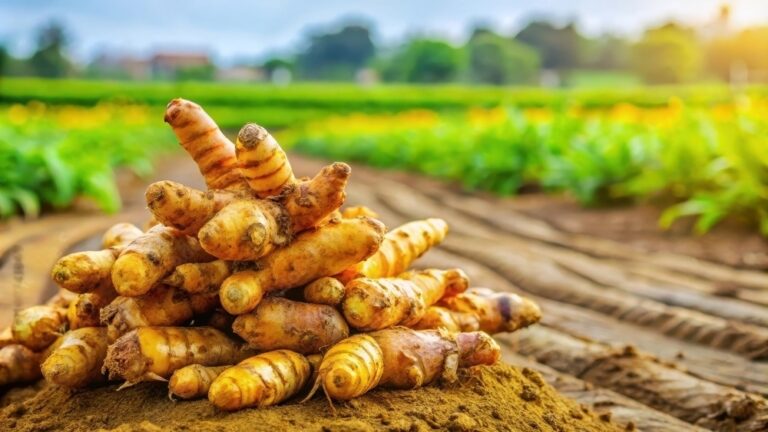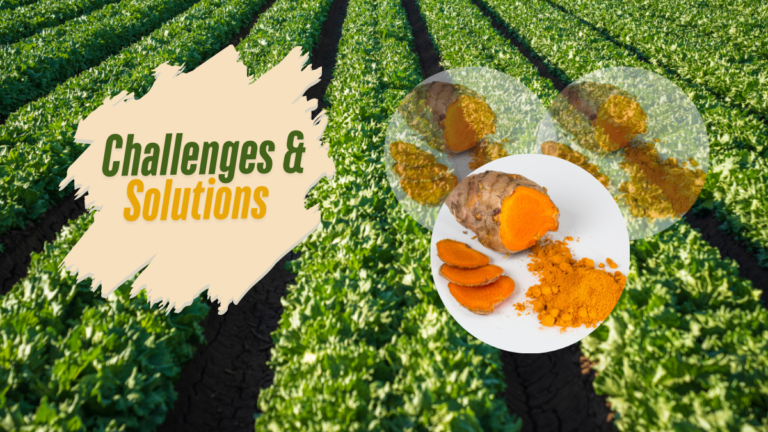Welcome to WordPress. This is your first post. Edit or delete it, then start writing!
Table of Contents
Toggle# Rajapuri Turmeric :-
Rajapuri turmeric is an exceptionally valued assortment of , known for its rich quality, solid fragrance, and energetic brilliant yellow tone. It is essentially filled in the prolific soils of India, especially in the areas of Tamil Nadu, Andhra Pradesh, and Karnataka. This assortment stands apart because of its high curcumin content, which is the compound liable for turmeric’s unmistakable variety and a significant number of its medical advantages.The rhizomes of Rajapuri are thick, stout, and have an unpleasant, uneven surface.
They are ordinarily bigger than different assortments, making them simple to deal with and process. The has a somewhat natural, peppery flavor with a warm, harsh connotation, making it ideal for culinary purposes, particularly in Indian and Southeast Asian cooking styles. This assortment stands apart because of its high curcumin content, which is the compound liable for turmeric’s unmistakable variety and a significant number of its medical advantages.The rhizomes of Rajapuri are thick, stout, and have an unpleasant, uneven surface.

Advantages of Rajapuri Turmeric :-
- High Curcumin Content:- Rajapuri contains a higher centralization of curcumin, making it more powerful than other turmeric assortments and ideal for both restorative and culinary purposes. It is likewise profoundly esteemed in the drug and health ventures for its job in battling persistent sicknesses. This high curcumin content improves the in general restorative worth of Rajapuri turmeric, going with it an exceptional decision on the lookout.
- Medical advantages:- Known for its calming, cell reinforcement, and antimicrobial properties, Rajapuri turmeric is broadly utilized in conventional medication to deal with conditions like joint agony, stomach related issues, and skin diseases. Diminishes irritation, giving alleviation from conditions like joint inflammation and joint agony. High curcumin content fortifies the safe framework, safeguarding against contaminations and illnesses. Works on stomach related wellbeing by animating bile creation and lessening bulging. Kills free extremists, lessening oxidative pressure and supporting generally cell wellbeing.
- Rich Flavor and Smell:- This assortment has a powerful, gritty flavor with a warm, somewhat harsh taste, improving the profundity and lavishness of dishes, particularly in curries and soups. this is known for its profound, natural aroma that upgrades the tangible allure of dishes. Ideal for zest mixes, conventional recipes, and refreshments like turmeric milk because of its fragrant lavishness. The solid fragrance and flavor are marks of its immaculateness and newness, pursuing it a favored decision for culinary and restorative purposes.
- Dynamic Tone:- Rajapuri grants a profound brilliant yellow shade, making it a sought-after element for regular food shading, beauty care products, and materials. The outwardly engaging dazzling yellow tone represents immaculateness and quality, adding a unique touch to any dish. Its versatile flavor supplements both customary and current recipes, making a novel culinary encounter. The energetic, hearty aroma of adds an elevating and strengthening quality to food and refreshments. Its dynamic presence stretches out past cooking, assuming an imperative part in health, skincare, and customary ceremonies.
- Financial Worth:- Because of its excellent curcumin content, Rajapuri orders a superior cost in both homegrown and global business sectors, helping neighborhood ranchers in Satara and Sangli. This is profoundly pursued in homegrown and global business sectors because of its unrivaled quality, driving solid deals and benefit. Its high curcumin content, energetic variety, and smell bring premium costs, making it a worthwhile yield for ranchers. Generally utilized in culinary, restorative, corrective, and modern areas, expanding its reasonable worth and adaptability. With predictable interest and flexibility to different developing circumstances, offers ranchers a consistent and dependable kind of revenue.
- Prevalent Capacity:- The bigger, thicker rhizomes of Rajapuri consider better taking care of, drying, and capacity, keeping up with intensity for longer periods. Known for its versatility, it is utilized in various areas, including culinary, restorative, and corrective applications. Its enormous rhizomes and powerful development guarantee superb creation, settling on it a favored decision for cultivators. Assumes a critical part in customary works on, improving its importance and request. Its quality and remarkable attributes have made it famous locally as well as in global business sectors.
- Social Significance:- Rajapuri holds social importance in the areas of Satara and Sangli, being utilized in conventional customs, celebrations, and Ayurvedic medicines. Rajapuri assumes a fundamental part in conventional functions, customs, and celebrations, profoundly implanted in the social texture of networks. Its boundless use in regular cures advances mindfulness about the advantages of all encompassing wellbeing rehearses across different populaces. As a high-esteem crop, it upholds neighborhood ranchers monetarily, further developing vocations and encouraging local area development.The development of this assortment empowers eco-accommodating cultivating works on, advancing maintainability inside provincial rural networks.

🌴 Farming of Rajpuri Turmeric 🌴
Step 1: Selection of Land
Optimal Soil :- Pick very much depleted loamy or sandy soil with pH between 5.5 to 7.5
Planning :- Furrow the land 2-3 times to accomplish a fine tilth. Add natural matter like farmstead fertilizer (FYM) or manure (10-12 tons/section of land).
Environment :- Rajapuri flourishes in heat and humidities with temperatures going from 20-30°C and a yearly precipitation of 1500-2000 mm.
Step 2: Seed Selection and Treatment
Assortment :- Select illness free, high-yielding Rajapuri rhizomes. Seed Rate: Utilize 800-1000 kg of seed rhizomes per section of land. Treatment :- Deal with the rhizomes with a fungicide arrangement like Carbendazim (2 g/liter of water) for 30 minutes. For bug counteraction, absorb the rhizomes a neem oil arrangement (5 ml/liter of water).
Step 3: Planting
Season :- Planting is best finished during the pre-storm season (April to May) for rainfed crops or according to water system accessibility.
Dispersing :- Keep 20-30 cm among columns and 15-20 cm between plants.
Profundity :- Plant rhizomes 5-7 cm profound, guaranteeing the buds face up.
Step 4: Irrigation
Rainfed :- Precipitation ought to get the job done during the storm. Supplemental water system might be expected in droughts.
Inundated :- Give water system each 7-10 days during the development stage. Decrease watering nearer to gather to forestall rhizome rot.
Step 5: Nutrient Management
Natural Information sources :- Utilize 10-12 tons of FYM or fertilizer per section of land prior to planting.
Substance Composts :-
Nitrogen (N): 40-50 kg/section of land
Phosphorus (P2O5): 20-25 kg/section of land
Potassium (K2O) :- 40-50 kg/section of land
Apply in 3 split dosages (at planting, 60 days, and 120 days subsequent to planting).
Micronutrients :- Utilize a foliar splash of micronutrient combinations on the off chance that lacks are noticed.
Step 6: Weed Management
Perform weeding 2-3 times during the editing cycle, particularly during the initial 60-90 days.
Mulch with dried leaves or straw to moderate dampness and control weeds.
Step 7: Pest and Disease Management
Normal Nuisances :-
Shoot drill: Apply neem-based splashes or natural control specialists like Trichogramma.
Normal Infections:
Rhizome decay: Use fungicides like Mancozeb (2.5 g/liter of water) and guarantee appropriate waste.
Routinely assess for vermin or infection invasions and make remedial moves instantly.
Step 8: Harvesting
Reaping in cultivating alludes to the most common way of gathering the experienced turmeric rhizomes (the underground stems of the plant) when they have completely evolved. It is a critical stage in cultivating in light of the fact that it straightforwardly influences the quality and amount of the yield. Development :- Rajapuri develops in 7-9 months. Collect when leaves become yellow and begin drying (around December-January for April planting). Collecting Strategy :- Relax soil around the plants and cautiously lift the rhizomes with a spade or digger.
Step 9: Post-Harvest Processing
Bubbling: Bubble gathered rhizomes in water with lime (1 kg lime for every 100 liters of water) for 30-45 minutes to eliminate crude smell. Drying :- Sun-dry the bubbled rhizomes for 10-15 days until they arrive at 8-10% dampness. Cleaning :- Clean dried rhizomes to further develop appearance (manual or mechanical cleaning). Powdering (discretionary) :- For turmeric powder creation, grind the cleaned rhizomes.
Step 10: Marketing
Nearby Business sectors :- Sell in neighborhood mandis or straightforwardly to zest dealers. Send out :- If plausible, investigate trade potential open doors as Rajapuri has a popularity in global business sectors. Esteem Expansion :- Consider marking and selling as natural turmeric or bundled powder for higher benefits.
Profit Analysis
-
Cost of Cultivation (per acre):
- Land preparation: ₹5,000-7,000
- Seed rhizomes: ₹40,000-50,000
- Fertilizers and pesticides: ₹10,000-15,000
- Labor (planting, weeding, harvesting): ₹15,000-20,000
- Total: ₹70,000-90,000
-
Yield:- Average yield is 20-25 quintals per acre (raw turmeric)
-
Selling Price:- Market price for dried: ₹120-200/kg (varies by quality and demand).
-
Gross Income:- 20 quintals x ₹150/kg = ₹3,00,000 (approx.).
-
Net Profit:- ₹3,00,000 – ₹90,000 = ₹2,10,000 per acre.
⚠ Challenges in Turmeric Farming and Solutions to Them ⚠
⏩ Key Challenges in Turmeric Farming
-
Pest and Disease Infestation :- Normal bugs like shoot drills and illnesses, for example, rhizome decay can seriously lessen yields and influence crop quality. Abuse of synthetic pesticides can prompt natural debasement and obstruction in bothers.
-
Soil Degradation :- Ceaseless trimming without renewing supplements exhausts soil richness.
Imbalanced utilization of synthetic manures prompts unfortunate soil wellbeing. - Water Management Issues :- Turmeric requires predictable water system, and unpredictable precipitation or absence of water the board frameworks can influence development.
Overabundance water can cause waterlogging, prompting rhizome decay. - Market Fluctuations :- Erratic market costs and the association of brokers frequently lessen ranchers’ benefits.
Absence of mindfulness about market patterns and commodity open doors adds to the issue. - High Production Costs :- The expense of value seeds, composts, and work frequently offsets the profits, particularly for limited scope ranchers.
Restricted admittance to reasonable supporting choices adds to the weight. - Lack of Technical Knowledge :- Numerous ranchers know nothing about cutting edge cultivating procedures, natural strategies, or post-reap handling that could increment productivity.

 How to Solve These Challenges with Resources
How to Solve These Challenges with Resources
-
Integrated Pest and Disease Management (IPDM) :- Utilize organic controls, for example, presenting regular hunters like Trichogramma wasps, to lessen bugs. Turn harvests to forestall the development of soil-borne infections. Apply natural fungicides, similar to neem oil, and guarantee appropriate seepage to forestall rhizome decay. Resources = Nearby rural augmentation administrations, bug control items from Krishi Vigyan Kendras (KVKs), and natural cultivating cooperatives.
-
Improving Soil Health :- Use organic fertilizers, like compost and green manure, to replenish soil nutrients. Practice crop rotation and add legumes to the cropping cycle to fix nitrogen in the soil. Conduct regular soil testing to determine nutrient deficiencies and amend accordingly. Resources = Soil health cards provided by government schemes, organic fertilizer suppliers, and training programs from agricultural universities.
-
Efficient Water Management :- Install drip irrigation systems to ensure efficient water use and reduce wastage. Create water storage systems, such as farm ponds, to store rainwater for irrigation during dry spells. Level fields properly to prevent waterlogging and ensure even distribution. Resources = Government subsidies for drip irrigation, NGOs providing water management training, and rural development schemes.
-
Enhancing Market Access :- Form farmer producer organizations (FPOs) to eliminate middlemen and negotiate better prices. Explore online platforms like e-NAM (National Agriculture Market) to connect with buyers directly. Invest in post-harvest processing units for value addition, such as turmeric powder or curcumin extraction. Resources = Government e-market platforms, agricultural cooperatives, and training from agricultural export agencies.
- Reducing Production Costs :- Use high-yielding and disease-resistant varieties like Rajapuri to maximize returns. Adopt mechanization for planting, harvesting, and processing to reduce labor costs. Leverage government loans and subsidies for agricultural inputs and machinery. Resources = NABARD loans, state subsidies on farm machinery, and seed distribution programs.
-
Training and Capacity Building :- Attend workshops and training programs on sustainable farming, organic practices, and advanced techniques. Collaborate with agricultural universities and extension offices for technical support. Utilize digital platforms like YouTube channels or mobile apps offering tutorials on farming. Resources = Krishi Vigyan Kendras, ICAR (Indian Council of Agricultural Research) initiatives, and farmer helplines.
✈ Export Opportunities ✈
Introduction :-
Rajapuri turmeric, known for its high curcumin content, vibrant color, and strong aroma, is a premium variety of highly sought after in international markets. With rising global demand for natural health products, spices, and organic ingredients, Rajapuri presents excellent export opportunities in Turmeric.
Exporting Rajapuri is a lucrative opportunity for farmers and entrepreneurs willing to invest in quality production, certification, and strategic marketing. With the right approach, resources, and government support, Indian turmeric can continue to dominate global spice markets.

-
High Global Demand for Turmeric :- This is widely used in the pharmaceutical, cosmetic, and food industries worldwide. Rajapuri turmeric’s high curcumin content makes it particularly attractive for health-conscious markets like the USA, Europe, and Japan.
-
Organic and Medicinal Product Boom :- Consumers are shifting towards organic and natural products, increasing the demand for organic Rajapuri turmeric. It is used in curcumin-based supplements, herbal teas, and Ayurvedic medicines, boosting its appeal globally.
- Popular Markets for Turmeric Export :- USA and Canada: High demand for turmeric powder, capsules, and organic turmeric products. Europe: Use in food products, cosmetics, and herbal supplements. Middle East: Popular in traditional cuisines and herbal medicines. Southeast Asia: Turmeric is widely consumed in culinary and medicinal applications.
-
Government Support and Trade Agreements :- India’s government actively promotes turmeric export by offering subsidies and incentives. Trade agreements with various countries reduce tariffs on agricultural products, making Indian turmeric more competitive.
🌳 Successful Case Study of Turmeric Farming in Maharashtra 🌳
Parbhani (Maharashtra) :- After two consecutive years of failure, Hemantrao Adalkar,(Click for Marathi Language) former mayor and experimental farmer of Selu (Parbhani district), has succeeded in earning an income of Rs 2.5 lakh per acre from organic turmeric crop this year. This has created a conducive environment for turmeric cultivation in the Selu area in the coming years. Adalkar has been cultivating crop in the Vaki Shivar area for the last three years.
However, due to lack of proper technology and guidance, and the vagaries of nature, he had to face failure for two consecutive years. He had to bear more cost for production than income. But this season, he planted Salem variety turmeric seedlings with great hope in six and a half acres. Before planting, he used ten tractor trolleys of cow dung per acre. Along with organic fertilizer, organic fertilizer available from the Agricultural University, minerals, along with curd, jaggery, lime stone, groundnut soil, wild neem leaves, and five kg of ground jaggery
. Minerals were given through drench. As a result, the turmeric was well-nourished and flourished. A pit of raw Rajpuri weighed seven and a half kilograms at harvest. The raw Rajpuri was cooked and dried. About two hundred quintals of ready-made Halkund Adalkar has been produced, equivalent to 35 to 40 quintals per acre. More than two hundred small and big farmers grow turmeric in the Valur area of Selu taluka.

Ranchers like Rajendra Toshniwal, Krishna Solapure, and Santosh Soni have huge development regions, while Sakharam Revanwar and others have begun handling enterprises, helping neighborhood ranchers. In spite of the fact that turmeric development in Selu is less contrasted with Valur, Hemantrao Adalkar shared that following two years of difficulties, they procured ₹2.5 lakh per section of land this year by taking on new innovation and natural composts.


Hi, this is a comment.
To get started with moderating, editing, and deleting comments, please visit the Comments screen in the dashboard.
Commenter avatars come from Gravatar.